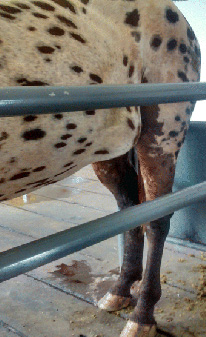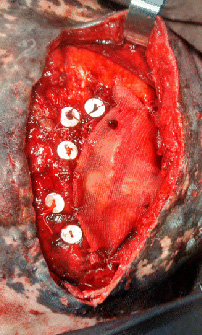Abdominal Hernia Repair in Horses Using Polyester…?

Photograph demonstrating the equine presenting increased volume on the left ventral-lateral region due to trauma
© Orlandini et al. 2016
Abdominal Hernia Repair
Equine Science Update by: Mark Andrews
Kick wounds to the lower abdomen of the horse can result in hernias. Although the skin remains intact, the underlying muscle layers may rupture, resulting in a soft swelling, with the intestines lying just beneath the skin. Adhesions may occur, and the intestines can become trapped and cause colic.
Such wounds are challenging to treat because of the weight of the abdominal contents bearing down on the surgical repair. The damaged muscle layers may not be strong enough to withstand the tension on the sutures used to repair the defect. It is often necessary to implant some mesh to strengthen the damaged muscle layers and repair the defect. Even then, there is a danger that the tension on the stitches will disrupt the wound.
One such case was reported in BMC Veterinary Research. Carla Faria Orlandini and others describe the successful use of polyester buttons and polypropylene mesh to repair an abdominal hernia, after a previous surgical repair had broken down.
The patient, a three-year-old male Appaloosa weighting 500 Kg, had developed a swelling of the lower abdomen following a collision with a farm fence. The authors suggest that the recurrence of the hernia after the first surgery was probably related to the weakness presented by the lacerated muscles, with high friability and inflammation.

Photograph illustrating a horse undergoing surgery for treatment of traumatic eventration demonstrating the synthetic materials, polyester buttons and polypropylene mesh used for reconstruction of the obliquus and transverse abdominis
© Orlandini et al. 2016
The second surgical repair used polypropylene mesh, to reinforce the suture line, and polyester buttons to prevent the sutures pulling through the muscle. The animal returned to its normal routine 30 days after the procedure.
The authors say that “the materials used to reinforce the abdominal suture were easy to apply, had good interaction with the suture, and excellent resistance to traction, even when inserted in heavily lacerated muscle.”
They conclude that the use of polyester buttons and polypropylene mesh, “provided effective reinforcement to the abdominal tension and was deemed an effective option for reconstruction of lacerated muscles after post-traumatic eventration in a horse.”
For more details, see:










